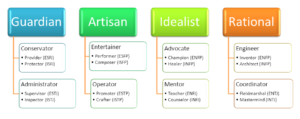Being a leader in a non-profit organization can be very demanding. But at the…
Myers-Briggs Types versus Keirsey Temperament Sorter
In our previous blog, Psychological Tests – Why do they matter in Executive Search?, we discussed the importance of psychological tests in the recruitment process especially when filling out executive level positions.
There are a lot of tests out there that could help head-hunters and other organizations to determine the suitability of the candidates in various positions. Outlined below are two major psychometric tests that are commonly used today.
Myers-Briggs Types
This assessment tool enables users to understand Carl Jung’s theory of psychological types. This test is helpful in the areas of team development, leadership development, conflict management, stress management as well as career transition and planning. 1 This was developed by Katharine Cook Briggs and Isabel Briggs Myers.
This was based on the Carl Jung’s theory of two dichotomous pairs of cognitive functions such as the rational and irrational functions. It has been believed that individuals are either born with or develops a certain way of decision-making and perception. The test helps sort out these psychological differences and come up with 16 personality types.
These types are expressed in an abbreviation of letters.

With the MBTI tests, it helps you answer the following questions:
Do you tend to focus on the outer world or your inner world? Extraversion (E) or Introversion (I).
Do you focus on the actual information you get, or do you prefer to interpret and analyze? Sensing (S) or Intuition (N).
Do you prefer to get things decided, or do you prefer to stay open to new information and possibilities? Judging (J) or Perceiving (P)
Do you prefer to prioritize logic or do you feel the need to first check the people and situation? Thinking (T) or Feeling (F). 2
For more information about the 16 personality types, click here.
Click here to view links to free MBTI tests
Keirsey Temperament Sorter
This assessment tool was developed by David Keirsey. It is based on the four – factor model of MBTI but Keirsey Temperament Sorter focuses on behavior rather than thoughts. 1 It features 4 temperaments, namely: Artisan and Idealist, Rational and Guardian. Keirsey further divided this temperament into two categories (roles), each with two types (role variants) ,and thus, come up with a result of 16 types.
The figure below shows the 16 types of temperament that correlate with the 16 personality types described by Briggs Myers. 2

Guardians are responsible. They know how to follow rules. They have high respect for authority and others. They believe in the importance of security and concepts of justice. They have very good management and organizational skills.
Artisans are doers. They are people who love action even if they have to bend the rules to get something done. They are fun, spontaneous and have a great positive outlook. They are the ones who are highly creative.
Idealists are people who love to imagine and think about possibilities. They are focused on human potential and building great relationship with others. They are known to be loving, helpful and enthusiastic. They are goal oriented without compromising the proper Code of Ethics.
Rationals are thinkers and focused on the present. They are inclined to find answers to problems. They are independent, strong-willed and goal oriented. They believe in reason and logic. They love to understand how things work.
Similarities and Differences
Michelle Collins, author of an article, “Understanding Personalities Can Lead to Better Performance”, mentioned that the Myers-Briggs Indicator and the Keirsey Temperament Sorter have a lot of things in common:
- What motivates or excites a person
- How a person processes information and their environment
- How they make decisions, and
- How they want to live their lives
Despite the correlation between the two psychometric tests, there are also differences in terms of its focus and descriptors. Based on the article, “The Four Dimension of Myers”, and the Keirsey.com website, the differences are as follows:
- Myers focuses on how people think and feel while Keirsey focuses more on behavior.
- Myers’ descriptions use a linear four-factor model while Keirsey’s descriptions use a systems field theory model.
- Myers emphasized the extraversion/introversion (expressive/attentive) dichotomy while Keirsey’s model places greater importance on the sensing/intuition (concrete/abstract) dichotomy.
- Lastly, Myers grouped types by ‘function attitudes while Keirsey grouped types by temperament.
Needless to say, both models are very useful and informative in terms of selecting the right candidate to fill in an executive level role within the organization. Some companies even use both methods for a more comprehensive profiling.
Have you tried any of these personality tests before? If so, what was your type? Please share your personality types below.



